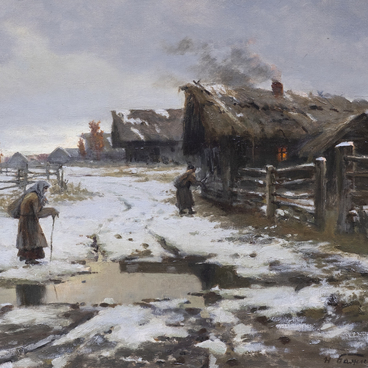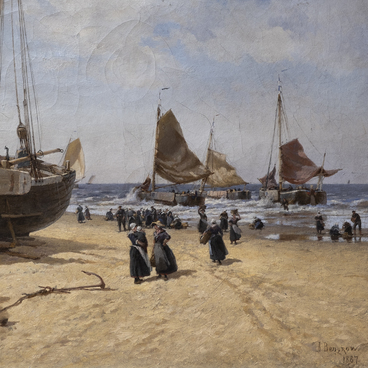“Southern Landscape” is one of the early works by the Russian artist Lev Lvovich Kamenev, painted in 1864.
Little is known about the childhood years of Lev Kamenev: he was born into a family of a poor merchant in Rylsk, Kursk Governorate, in 1833. He did not complete his studies at the Astrakhan Secondary School because his father needed an assistant at his shop. Nevertheless, in 1854, Lev Kamenev, who had been drawing since childhood, entered the Moscow School of Painting, Sculpture and Architecture where he studied landscape and perspective under the guidance of Professor Karl Ivanovich Rabus. The painter’s artistic development was greatly influenced by the young teacher Alexey Kondratyevich Savrasov. After graduating in 1857, Lev Kamenev traveled extensively throughout Europe. In 1869, he was awarded the title of academician by the Imperial Academy of Arts. In 1871, he became one of the founders of the Society of Traveling Art Exhibitions and participated in its events until 1884.
Lev Kamenev was a member of the Society of Art Lovers, and in 1862, the organization sent him on a foreign trip so that he could improve his skills and see the works of Western European artists. He traveled together with Ivan Shishkin whose trip to Germany and Switzerland was sponsored by the Academy of Arts. It was during this journey that Lev Kamenev painted “Southern Landscape” based on numerous studies.
Despite not having studied at an academic school,
the young artist followed all the rules of academic composition. He divided the
painting into three sections. The foreground is detailed and mostly dark. The
middle ground is formed by the giant silent mountains, and the background is
represented by the magnificent sky and snow-capped summits shrouded in fog
slowly dissipating under the sun. According to the academic tradition, the
landscape includes a genre scene with peasants that bring life to the picture.
The majestic trees with lush crowns contribute to the sublime image of the
power of nature.



